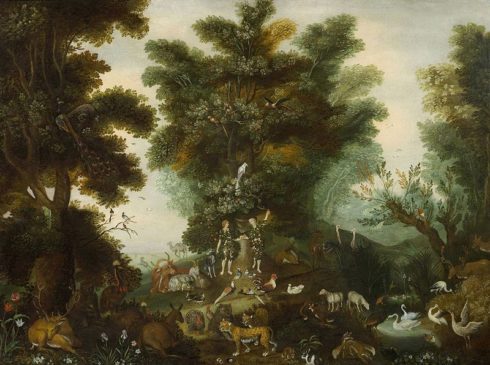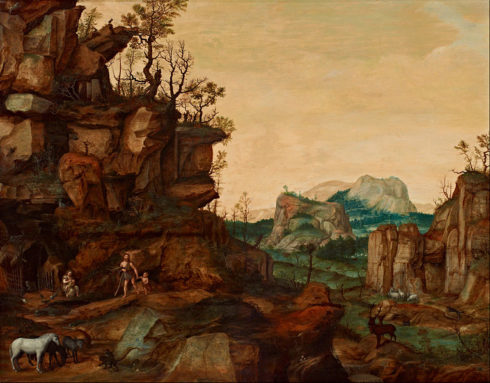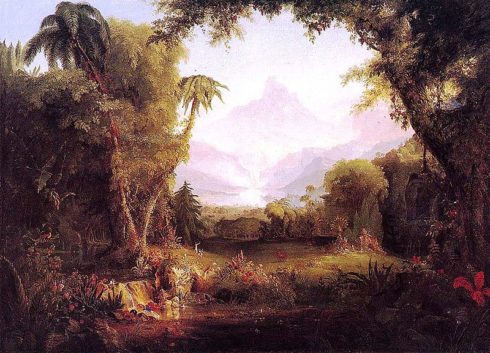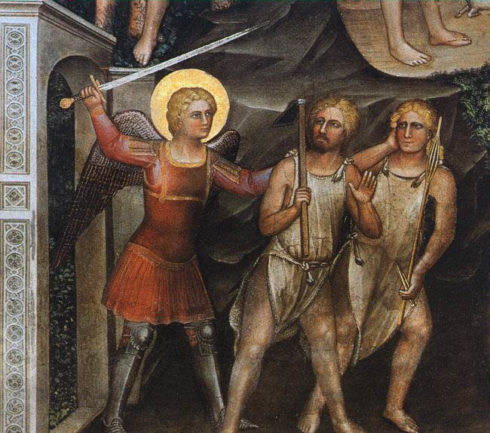Adam
The first man and the father of the human race.
ETYMOLOGY AND USE OF WORD
There is not a little divergence of opinion among Semitic scholars when they attempt to explain the etymological signification of the Hebrew word adam (which in all probability was originally used as a common rather than a proper name), and so far no theory appears to be fully satisfactory. One cause of uncertainty in the matter is the fact that the root adam as signifying “man” or “mankind” is not common to all the Semitic tongues, though of course the name is adopted by them in translations of the Old Testament. As an indigenous term with the above signification, it occurs only in Phoenician and Sabean, and probably also in Assyrian. In Gen., ii, 7, the name seems to be connected with the word ha-adamah (“the ground”), in which case the value of the term would be to represent man (ratione materiæ) as earthborn, much the same as in Latin, where the word homo is supposed to be kindred with humus. It is a generally recognized fact that the etymologies proposed in the narratives which make up the Book of Genesis are often divergent and not always philologically correct, and though the theory (founded on Gen., ii, 7) that connects adam with adamah has been defended by some scholars, it is at present generally abandoned. Others explain the term as signifying “to be red”, a sense which the root bears in various passages of the Old Testament (e.g. Gen., xxv, 50), as also in Arabic and Ethiopic. In this hypothesis the name would seem to have been originally applied to a distinctively red or ruddy race. In this connection Gesenius (Thesaurus, s.v., p. 25) remarks that on the ancient monuments of Egypt the human figures representing Egyptians are constantly depicted in red, while those standing for other races are black or of some other colour. Something analogous to this explanation is revealed in the Assyrian expression çalmât qaqqadi, i.e. “the black-headed”, which is often used to denote men in general. (Cf. Delitsch, Assyr. Handwörterbuch, Leipzig, 1896, p. 25.) Some writers combine this explanation with the preceding one, and assign to the word adam the twofold signification of “red earth”, thus adding to the notion of man’s material origin a connotation of the color of the ground from which he was formed. A third theory, which seems to be the prevailing one at present (cf. Pinches, The Old Testament in the Light of the Historical Records and Legends of Assyria and Babylonia, 1903, pp. 78, 793), explains the root adam as signifying “to make”, “to produce”, connecting it with the Assyrian adamu, the meaning of which is probably “to build”, “to construct”, whence adam would signify “man” either in the passive sense, as made, produced, created, or in the active sense, as a producer.
In the Old Testament the word is used both as a common and a proper noun, and in the former acceptation it has different meanings. Thus in Genesis ii, 5, it is employed to signify a human being, man or woman; rarely, as in Gen., ii, 22, it signifies man as opposed to woman, and, finally, it sometimes stands for mankind collectively, as in Gen., i, 26. The use of the term, as a proper as well as a common noun, is common to both the sources designated in critical circles as P and J. Thus in the first narrative of the Creation (P) the word is used with reference to the production of mankind in both sexes, but in Gen., v, 14, which belongs to the same source, it is also taken as a proper name. In like manner the second account of the creation (J) speaks of “the man” (ha-adam), but later on (Gen., iv, 25) the same document employs the word as a proper name without the article.
ADAM IN THE OLD TESTAMENT
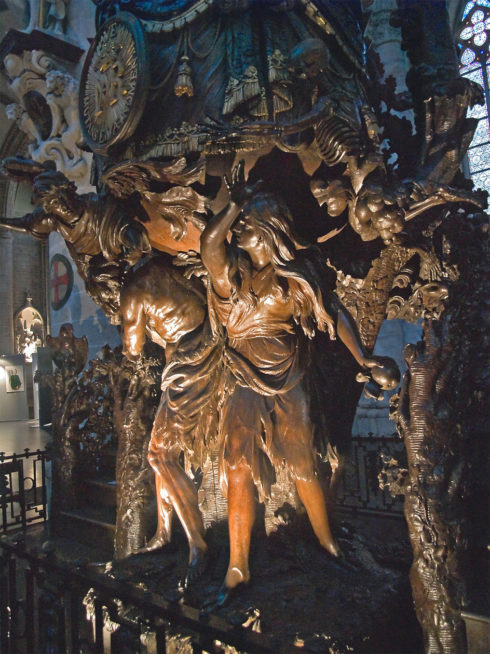
Adam and Eve expelled from Eden, detail of the pulpit carved by Hendrik Frans Verbruggen (1699), St. Michael and St. Gudula Cathedral, Brussels, Belgium. Photo taken by Myrabella
Practically all the Old Testament information concerning Adam and the beginnings of the human race is contained in the opening chapters of Genesis. To what extent these chapters should be considered as strictly historical is a much disputed question, the discussion of which does not come within the scope of the present article. Attention, however, must be called to the fact that the story of the Creation is told twice, viz. in the first chapter and in the second, and that while there is a substantial agreement between the two accounts there is, nevertheless, a considerable divergence as regards the setting of the narrative and the details. It has been the custom of writers who were loath to recognize the presence of independent sources or documents in the Pentateuch to explain the fact of this twofold narrative by saying that the sacred writer, having set forth systematically in the first chapter the successive phases of the Creation, returns to the same topic in the second chapter in order to add some further special details with regard to the origin of man. It must be granted, however, that very few scholars of the present day, even among Catholics, are satisfied with this explanation, and that among critics of every school there is a strong preponderance of opinion to the effect that we are here in presence of a phenomenon common enough in Oriental historical compositions, viz. the combination or juxtaposition of two or more independent documents more or less closely welded together by the historiographer, who among the Semites is essentially a compiler. (See Guidi, L’historiographie chez les Sémites in the Revue biblique, October, 1906.) The reasons on which this view is based, as well as the arguments of those who oppose it, may be found in Dr. Gigot’s Special Introduction to the Study of the Old Testament, Pt. I. Suffice it to mention here that a similar repetition of the principal events narrated is plainly discernible throughout all the historic portions of the Pentateuch, and even of the later books, such as Samuel and Kings, and that the inference drawn from this constant phenomenon is confirmed not only by the difference of style and viewpoint characteristic of the duplicate narratives, but also by the divergences and antinomies which they generally exhibit. Be that as it may, it will be pertinent to the purpose of the present article to examine the main features of the twofold Creation narrative with special reference to the origin of man.
In the first account (Ch. i, ii, 4a) Elohim is represented as creating different categories of beings on successive days. Thus the vegetable kingdom is produced on the third day, and, having set the sun and moon in the firmament of heaven on the fourth, God on the fifth day creates the living things of the water and the fowls of the air which receive a special blessing, with the command to increase and multiply. On the sixth day Elohim creates, first, all the living creatures and beasts of the earth; then, in the words of the sacred narrative,
he said: Let us make man to our image and likeness: and let him have dominion over the fishes of the sea, and the fowls of the air, and the beasts, and the whole earth, and every creeping creature that moveth upon the earth. And God created man to his own image: to the image of God he created him: male and female he created them.
Then follows the blessing accompanied by the command to increase and fill the earth, and finally the vegetable kingdom is assigned to them for food. Considered independently, this account of the Creation would leave room for doubt as to whether the word adam, “man”, here employed was understood by the writer as designating an individual or the species. Certain indications would seem to favour the latter, e.g. the context, since the creations previously recorded refer doubtless to the production not of an individual or of a pair, but of vast numbers of individuals pertaining to the various species, and the same in case of man might further be inferred from the expression, “male and female he created them.” However, another passage (Gen., v, 15), which belongs to the same source as this first narrative and in part repeats it, supplements the information contained in the latter and affords a key to its interpretation. In this passage which contains the last reference of the so-called priestly document to Adam, we read that God
created them male and female . . . and called their name adam, in the day when they were created.
And the writer continues:
And Adam lived a hundred and thirty years, and begot a son to his own image and likeness, and called his name Seth. And the days of Adam, after he begot Seth, were eight hundred years and he begot sons and daughters. And all the time that Adam lived came to nine hundred and thirty years, and he died.
Here evidently the adam or man of the Creation narrative is identified with a particular individual, and consequently the plural forms which might otherwise cause doubt are to be understood with reference to the first pair of human beings. In Genesis, ii, 4b-25 we have what is apparently a new and independent narrative of the Creation, not a mere amplification of the account already given. The writer indeed, without seeming to presuppose anything previously recorded, goes back to the time when there was yet no rain, no plant or beast of the field; and, while the earth is still a barren, lifeless waste, man is formed from the dust by Yahweh, who animates him by breathing into his nostrils the breath of life. How far these terms are to be interpreted literally or figuratively, and whether the Creation of the first man was direct or indirect, see GENESIS, CREATION, MAN. Thus the creation of man, instead of occupying the last place, as it does in the ascending scale of the first account, is placed before the creation of the plants and animals, and these are represented as having been produced subsequently in order to satisfy man’s needs. Man is not commissioned to dominate the whole earth, as in the first narrative, but is set to take care of the Garden of Eden with permission to eat of its fruit, except that of the tree of the knowledge of good and evil, and the formation of woman as a helpmeet for man is represented as an afterthought on the part of Yahweh in recognition of man’s inability to find suitable companionship in the brute creation. In the preceding account, after each progressive step “God saw that it was good”, but here Yahweh perceives, as it were, that it is not good for man to be alone, and he proceeds to supply the deficiency by fashioning the woman Eve from the rib of the man while he is in a deep sleep. According to the same narrative, they live in childlike innocence until Eve is tempted by the serpent, and they both partake of the forbidden fruit. They thereby become conscious of sin, incur the displeasure of Yahweh, and lest they should eat of the tree of life and become immortal, they are expelled from the garden of Eden. Henceforth their lot is to be one of pain and hardship, and man is condemned to the toilsome task of winning his sustenance from a soil which on his account has been cursed with barrenness. The same document gives us a few details connected with our first parents after the Fall, viz.: the birth of Cain and Abel the fratricide, and the birth of Seth. The other narrative, which seems to know nothing of Cain or Abel, mentions Seth (Chap. v, 3) as if he were the first born, and adds that during the eight hundred years following the birth of Seth Adam begat sons and daughters.
Notwithstanding the differences and discrepancies noticeable in the two accounts of the origin of, mankind, the narratives are nevertheless in substantial agreement, and in the esteem of the majority of scholars they are easiest explained and reconciled if considered as representing two varying traditions among the Hebrews — traditions which in different form and setting embodied the selfsame central historic facts, together with a presentation more or less symbolical of certain moral and religious truths. Thus in both accounts man is clearly distinguished from, and made dependent upon, God the Creator; yet he is directly connected with Him through the creative act, to the exclusion of all intermediary beings or demigods such as are found in the various heathen mythologies. That man beyond all the other creatures partakes of the perfection of God is made manifest in the first narrative, in that he is created in the, image of God, to which corresponds in the other account the equally significant figure of man receiving his life from the breath of Yahweh. That man on the other hand has something in common with the animals is implied in the one case in his creation on the same day, and in the other by his attempt, though ineffectual, to find among them a suitable companion. He is the lord and the crown of creation, as is clearly expressed in the first account, where the creation of man is the climax of God’s successive works, and where his supremacy is explicitly stated, but the same is implied no less clearly in the second narrative. Such indeed may be the significance of placing man’s creation before that of the animals and plants, but, however that may be, the animals and plants are plainly created for his utility and benefit. Woman is introduced as secondary and subordinate to man, though identical with him in nature, and the formation of a single woman for a single man implies the doctrine of monogamy. Moreover, man was created innocent and good; sin came to him from without, and it was quickly followed by a severe punishment affecting not only the guilty pair, but their descendants and other beings as well. (Cf. Bennett in Hastings, Dict. of the Bible, s.v.) The two accounts, therefore, are practically at one with regard to didactic purpose and illustration, and it is doubtless to this feature that we should attach their chief significance. It is hardly necessary to remark in passing that the loftiness of the doctrinal and ethical truths here set forth place the biblical narrative immeasurably above the extravagant Creation stories current among the pagan nations of antiquity, though some of these, particularly the Babylonian, bear a more or less striking resemblance to it in form. In the light of this doctrinal and moral excellence, the question of the strict historical character of the narrative, as regards the framework and details, becomes of relatively slight importance, especially when we recall that in history as conceived by the other biblical authors, as well as by Semitic writers generally, the presentation and arrangement of facts — and indeed their entire role — is habitually made subordinate to the exigencies of a didactic preoccupation.
As regards extra-biblical sources which throw light upon the Old Testament narrative, it is well known that the Hebrew account of the Creation finds a parallel in the Babylonian tradition as revealed by the cuneiform writings. It is beyond the scope of the present article to discuss the relations of historical dependence generally admitted to exist between the two cosmogonies. Suffice it to say with regard to the origin of man, that though the fragment of the “Creation Epic”, which is supposed to contain it, has not been found, there are nevertheless good independent grounds for assuming that it belonged originally to the tradition embodied in the poem, and that it must have occupied a place in the latter just after the account given of the production of the plants and the animals, as in the first chapter of Genesis. Among the reasons for this assumption are:
- the Divine admonitions addressed to men after their creation, towards the end of the poem;
- the account of Berosus, who mentions the creation of man by one of the gods, who mixed with clay the blood which flowed from the severed head of Tiamat;
- a non-Semitic (or pre-Semitic) account translated by Pinches from a bilingual text, and in which Marduk is said to have made mankind, with the cooperation of the goddess Aruru.
(Cf. Encyclopedia Biblica, art. “Creation”, also Davis, Genesis and Semitic Tradition, pp. 36-47.) As regards the creation of Eve, no parallel has so far been discovered among the fragmentary records of the Babylonian creation story. That the account, as it stands in Genesis, is not to be taken literally as descriptive of historic fact was the opinion of Origen, of Cajetan, and it is now maintained by such scholars as Hoberg (Die Genesis, Freiburg, 1899, p. 36) and von Hummelauer (Comm. in Genesim, pp. 149 sqq.). These and other writers see in this narrative the record of a vision symbolical of the future and analogous to the one vouchsafed to Abraham (Gen., xv, 12 sqq.), and to St. Peter in Joppe (Acts, x, 10 sqq.). (See Gigot, Special Introduction to the Study of the Old Testament, pt. I, p. 165, sqq.) References to Adam as an individual in the later Old Testament books are very few, and they add nothing to the information contained in Genesis. Thus the name stands without comment at the head of the genealogies at the beginning of I Paralipomenon; it is mentioned likewise in Tobias, viii, 8; Osee, vi, 7; Ecclus., xxxv, 24, etc. The Hebrew word adam occurs in various other passages, but in the sense of man or mankind. The mention of Adam in Zacharias, xiii, 5, according to the Douay version and the Vulgate, is due to a mistranslation of the original.
ADAM IN THE NEW TESTAMENT
In the New Testament references to Adam as an historical personage occur only in a few passages. Thus in the third chapter of St. Luke’s Gospel the genealogy of the Saviour is traced back to “Adam who was of God”. This prolongation of the earthly lineage of Jesus beyond Abraham, who forms the starting point in St. Matthew, is doubtless due to the more universal spirit and sympathy characteristic of our third Evangelist, who writes not so much from the viewpoint of Jewish prophecy and expectation as for the instruction of the Gentile recruits to Christianity. Another mention of the historic father of the race is found in the Epistle of Jude (verse 14), where a quotation is inserted from the apocryphal Book of Enoch, which, rather strange to say, is attributed to the antediluvian patriarch of that name, “the seventh from Adam.” But the most important references to Adam are found in the Epistles of St. Paul. Thus in I Tim., ii, 11-14, the Apostle, after laying down certain practical rules referring to the conduct of women, particularly as regards public worship, and inculcating the duty of subordination to the other sex, makes use of an argument the weight of which rests more upon the logical methods current at the time than upon its intrinsic value as appreciated by the modern mind:
For Adam was first formed; then Eve. And Adam was not seduced; but the woman being seduced, was in the transgression.
A similar line of argument is pursued in I Cor., xi, 8, 9. More important is the theological doctrine formulated by St. Paul in the Epistle to the Romans, v, 12-21, and in I Cor., xv, 22-45. In the latter passage Jesus Christ is called by analogy and contrast the new or “last Adam.” This is understood in the sense that as the original Adam was the head of all mankind, the father of all according to the flesh, so also Jesus Christ was constituted chief and head of the spiritual family of the elect, and potentially of all mankind, since all are invited to partake of His salvation. Thus the first Adam is a type of the second, but while the former transmits to his progeny a legacy of death, the latter, on the contrary, becomes the vivifying principle of restored righteousness. Christ is the “last Adam” inasmuch as “there is no other name under heaven given to men, whereby we must be saved” (Acts, iv, 12); no other chief or father of the race is to be expected. Both the first and the second Adam occupy the position of head with regard to humanity, but whereas the first through his disobedience vitiated, as it were, in himself the stirps of the entire race, and left to his posterity an inheritance of death, sin, and misery, the other through his obedience merits for all those who become his members a new life of holiness and an everlasting reward. It may be said that the contrast thus formulated expresses a fundamental tenet of the Christian religion and embodies in a nutshell the entire doctrine of the economy of salvation. It is principally on these and passages of similar import (e.g. Matt., xviii, 11) that is based the fundamental doctrine that our first parents were raised by the Creator to a state of supernatural righteousness, the restoration of which was the object of the Incarnation. It need hardly be said that the fact of this elevation could not be so clearly inferred from the Old Testament account taken independently.
ADAM IN JEWISH AND CHRISTIAN TRADITION
It is a well-known fact that, partly from a desire to satisfy pious curiosity by adding details to the too meagre biblical accounts, and partly with ethical intent, there grew up in later Jewish as well as in early Christian and Mohammedan tradition a luxuriant crop of legendary lore around the names of all the important personages of the Old Testament. It was therefore only natural that the story of Adam and Eve should receive special attention and be largely developed by this process of embellishment. These additions, some of which are extravagant and puerile, are chiefly imaginary, or at best based on a fanciful understanding of some slight detail of the sacred narrative. Needless to say that they do not embody any real historic information, and their chief utility is to afford an example of the pious popular credulity of the times as well as of the slight value to be attached to the so-called Jewish traditions when they are invoked as an argument in critical discussion. Many rabbinical legends concerning our first parents are found in the Talmud, and many others were contained in the apocryphal Book of Adam now lost, but of which extracts have come down to us in other works of a similar character (see MAN). The most important of these legends, which it is not the scope of the present article to reproduce, may be found in the Jewish Encyclopedia, I, art. “Adam”, and as regards the Christian legends, in Smith and Wace, Dictionary of Christian Biography, s.v.
PALIS in VIG., Dict. de la Bible, s.v.; BENNETT and ADENEY in HAST., Dict. of the Bible, s.v. For New Testament references, see commentaries; for Old Testament, GIGOT, Special Introduction to the Study of the Old Testament, I, iv; VON HUMMELAUER, Comm. in Genesis.
James F. Driscoll (Catholic Encyclopedia)
____________________________
Eve
(Heb. CHWH, hawwah).
The name of the first woman, the wife of Adam, the mother of Cain, Abel, and Seth. The name occurs only five times in the Bible. In Gen., iii, 20, it is connected etymologically with the verb CHYH or CHWH, “to live”: “And Adam called the name of his wife Eve [CHWH, hawwah]: because she was the mother of all the living”. The Septuagint rendering in this passage is Zoe (=life, or life-giver), which is a translation; in two other passages (Gen., iv, 1 and 25) the name is transliterated Eu a. The Biblical data concerning Eve are confined almost exclusively to the second, third, and fourth chapters of Genesis (see Adam).
The first account of the creation (Gen. i, “P”) sets forth the creation of mankind in general, and states simply that they were created male and female. The second narrative (Gen., ii, “J”) is more explicit and detailed. God is represented as forming an individual man from the slime of the earth, and breathing into his nostrils the breath of life. In like manner the creation of the first woman and her relation to man is described with picturesque and significant imagery. In this account, in which the plants and animals appear on the scene only after the creation of man, the loneliness of the latter (Gen., ii, 18), and his failure to find a suitable companion among the animals (Gen., ii, 20), are set forth as the reason why God determines to create for man a companion like unto himself. He causes a deep sleep to fall upon him, and taking out one of his ribs, forms it into a woman, who, when she is brought to him, is recognized at once as bone of his bone and flesh of his flesh. A discussion of the arguments in favor of the historical, or the more or less allegorical character of this narrative would be beyond the scope of the present notice. Suffice it to say that the biblical account has always been looked upon by pious commentators as embodying, besides the fact of man’s origin, a deep, practical and many-sided significance, bearing on the mutual relationship established between the sexes by the Creator.
Thus, the primitive institution of monogamy is implied in the fact that one woman is created for one man. Eve, as well as Adam, is made the object of a special creative act, a circumstance which indicates natural equality with him, while on the other hand her being taken from his side implies not only her secondary role in the conjugal state (I Cor., xi, 9), but also emphasizes the intimate union between husband and wife, and the dependence of the latter on the former “Wherefore a man shall leave father and mother, and shall cleave to his wife: and they shall be two in one flesh.” The innocence of the newly created couple is clearly indicated in the following verse, but the narrator immediately proceeds to relate how they soon acquired, through actual transgression, the knowledge of good and evil, and with it the sense of shame which had been previously unknown to them. In the story of the Fall, the original cause of evil is the serpent, which in later Jewish tradition is identified with Satan (Wisdom, ii, 24). He tempts Eve presumably as the weaker of the two, and she in turn tempts Adam, who yields to her seduction. Immediately their eyes are opened, but in an unexpected manner. Shame and remorse take possession of them, and they seek to hide from the face of the Lord.
For her share in the transgression, Eve (and woman-kind after her) is sentenced to a life of sorrow and travail, and to be under the power of her husband. Doubtless this last did not imply that the woman’s essential condition of equality with man was altered, but the sentence expresses what, in the nature of things, was bound to follow in a world dominated by sin and its consequences. The natural dependence and subjection of the weaker party was destined inevitably to become something little short of slavery. But if woman was the occasion of man’s transgression and fall, it was also decreed in the Divine counsels, that she was to be instrumental in the scheme of restoration which God already promises while in the act of pronouncing sentence upon the serpent. The woman has suffered defeat, and infinitely painful are its consequences, but henceforth there will be enmity between her and the serpent, between his seed and her seed, until through the latter in the person of the future Redeemer, who will crush the serpent’s head, she will again be victorious.
Of the subsequent history of Eve the Bible gives little information. In Gen., iv, 1, we read that she bore a son whom she named Cain, because she got him (QNH—to acquire, possess) through God—this at least is the most plausible interpretation of this obscure passage. Later she gave birth to Abel, and the narrative does not record the birth of another child until after the slaying of Abel by his elder brother, when she bore a son and called his name Seth; saying: “God hath given me [SYT—put or appoint] another seed, for Abel whom Cain slew”. Of daughters no specific mention is made in this account, but in Gen., v, 4 (“P”) we find the general statement that “the days of Adam, after he begot Seth, were eight hundred years: and he begot sons and daughters”.
Eve is mentioned in the Book of Tobias (viii, 8; Sept., viii, 6) where it is simply affirmed that she was given to Adam for a helper; in II Cor., xi, 3, where reference is made to her seduction by the serpent, and in I Tim., ii, 13, where the Apostle enjoins submission and silence upon women, arguing that “Adam was first formed; then Eve. And Adam was not seduced, but the woman being seduced, was in the transgression”.
As in the case of the other Old Testament personages, many rabbinical legends have been connected with the name of Eve. They may be found in the “Jewish Encyclopedia”, s.v. (see also, Adam), and in Vigouroux, “Dictionnaire de la Bible”, I, art. “Adam”. They are, for the most part, puerile and fantastic, and devoid of historical value, unless in so far as they serve to illustrate the mentality of the later Jewish writers, and the unreliability of the “traditions” derived from such sources, though they are sometimes appealed to in critical discussions.
James F. Driscoll (Catholic Encyclopedia)
